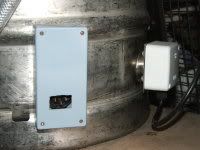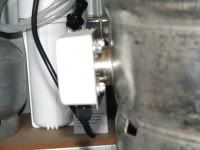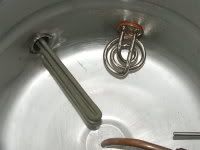Plastic Man
Well-Known Member
- Joined
- 4/11/04
- Messages
- 483
- Reaction score
- 0
Hello to all - been lurking for a while - but now need some help...
I know this is asking a bit but can someone who is using either a 2400 or 2200 watt immersion heater, or a kettle element, do me a BIG favour and shoot back the wattage, length and OD of the element.
Reason: Im planning on doing my my first AG batch in a few weeks. Ive made a HLT from a bunnings 25l drum with a Big W Belle kettle 2200W element installed. A 20mm to 15mm brass reducer screwed straight into the bung hole and a inch ball valve screwed straight onto this. Not a bad option for anyone wanting a HLT, (Bunnings bits about $25 and $10 Belle kettle from Big W, (even has a light showing it is on !!) use a 38mm hole saw to cut the element hole. It then fits in no problem using the bulkhead fitting from the kettle).
Made the mash tun from a 25l esky, (currently $24 at bunnings), some 15mm threaded brass pipe, a few lock nuts and washers and a converted SS braided hose connection with the inner hose removed. Added a inch ball valve to the outside. Cost about $50 all up.
No issues up to here but now for the kettle. Bought a 30l cube from bunnings with the wide opening, ($15). No bung hole so Ill add a bulkhead fitting with a ball valve on the outside. But the question is what element to add. At $10 a pop Id love to just wack in another $10 2200W kettle element from Big W but am worried it will scorch the wort. Option is to wack in 4 elements and run each pair in series for a total of 2200W, or try and buy two 1200W elements, (which isnt easy). Ill think Ill try the one element and see how it goes.
But just as a final double check, Id really like to check the power density of the immersion elements people are using. My $10 element is about 50cm long (if you untangled it). It is about 0.8cm OD so area is about 125cm2. So power density is 2200W / 125cm2 = 17.6 watts / cm2. From what I can glean from other posts on the web, a safe zone is somewhere between 8 13 watts / cm2. Im way over that but this doesnt seem to worry others who are boiling with one element. If any obliging fellow brewers can shoot though the wattage, the length and the OD of the elements they are using I can do a quick check and make a final call. Id just hate to do a full mash only to burn all the wort. Im sure I wont, but a double check would be nice.
Any help very much appreciated!!!
Richard.
I know this is asking a bit but can someone who is using either a 2400 or 2200 watt immersion heater, or a kettle element, do me a BIG favour and shoot back the wattage, length and OD of the element.
Reason: Im planning on doing my my first AG batch in a few weeks. Ive made a HLT from a bunnings 25l drum with a Big W Belle kettle 2200W element installed. A 20mm to 15mm brass reducer screwed straight into the bung hole and a inch ball valve screwed straight onto this. Not a bad option for anyone wanting a HLT, (Bunnings bits about $25 and $10 Belle kettle from Big W, (even has a light showing it is on !!) use a 38mm hole saw to cut the element hole. It then fits in no problem using the bulkhead fitting from the kettle).
Made the mash tun from a 25l esky, (currently $24 at bunnings), some 15mm threaded brass pipe, a few lock nuts and washers and a converted SS braided hose connection with the inner hose removed. Added a inch ball valve to the outside. Cost about $50 all up.
No issues up to here but now for the kettle. Bought a 30l cube from bunnings with the wide opening, ($15). No bung hole so Ill add a bulkhead fitting with a ball valve on the outside. But the question is what element to add. At $10 a pop Id love to just wack in another $10 2200W kettle element from Big W but am worried it will scorch the wort. Option is to wack in 4 elements and run each pair in series for a total of 2200W, or try and buy two 1200W elements, (which isnt easy). Ill think Ill try the one element and see how it goes.
But just as a final double check, Id really like to check the power density of the immersion elements people are using. My $10 element is about 50cm long (if you untangled it). It is about 0.8cm OD so area is about 125cm2. So power density is 2200W / 125cm2 = 17.6 watts / cm2. From what I can glean from other posts on the web, a safe zone is somewhere between 8 13 watts / cm2. Im way over that but this doesnt seem to worry others who are boiling with one element. If any obliging fellow brewers can shoot though the wattage, the length and the OD of the elements they are using I can do a quick check and make a final call. Id just hate to do a full mash only to burn all the wort. Im sure I wont, but a double check would be nice.
Any help very much appreciated!!!
Richard.







